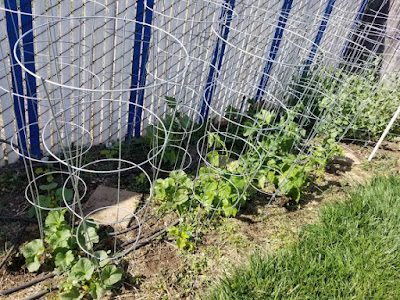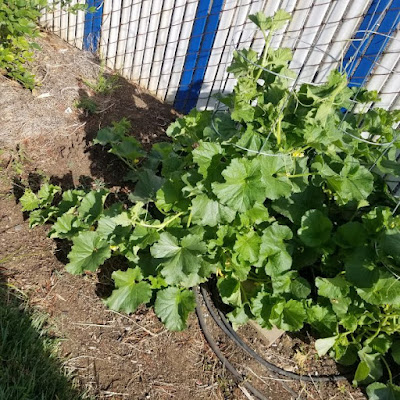For years, I have been offering seed of the Carosello Mezzo Lungo of Polignano and Mezzo Lungo of Barese melons (Cucumis melo) that are grown immature as cucumbers. However, until recently – I had never had the opportunity to grow them out in any way to distinguish the one Mezzo Lungo from another. One of my friends told me that after years of growing them, he could still not tell the two varieties apart.
Fortunately, there was one individual that was able to help me out. According to an Italian Gardening friend of mine, Angelo Passalaqua, the Medium Long of Barese is somewhat longer than the Polignano. With this information, along with some seed Angelo had sent me a number of Mezzo Lungo varieties and some that was purchased from a couple seed vendors, I was able to begin my Mezzo Lungo carosello trial.
As is often the case in my area of California, May-planted melons grow very slowly. I put my strawberry basket transplants of this variety out sometime before May 6th and the fruit was in full production around the end of May. Various critters take advantage of this fact and began attacking my plants along one of the sides of the planting. I just did my best, side dressed with compost and worm castings and prayed that I would at least get something. Very slowly, things started to improve until the plants began to grow fruit. Small fuzzy female flowers slowly budded and began to set fruit. Then the varietal selection could begin.
It quickly became apparent to me that the designation of “Barese” and “Polignano” did not have any bearing on how long the variety grew. Some of my Polignano seeds produced the longer, less fuzzy Barese-type cucumbers while some of my Barese seeds produced some of the shortest, most fuzzy Polignano-type cucumbers originated from some of my Mezzo Lungo Barese seeds. With this information, I looked over each sample population to determine which one exhibited traits that were the most “Barese” or “Polignano”.
In relation to other carosello cucumber varieties, both the Polignano and the Barese are very fuzzy and somewhat low in water content. Identifying the longer-fruited trait of the Mezzo Lungo Barese was easy because only one of the seed varieties that I grew produced long, somewhat fuzzy fruit. I let that variety go to seed and began looking over the other plants to see if I could identify one that produced short, yet extremely fuzzy fruit. While the seed of the Mezzo Lungo Polignano from Emanuele Larosa was very consistent (a trait that can be difficult to achieve with many carosello varieties) the lack of heavy fuzz led me to believe that my future seed for the Polignano would not be from Emanuele Larosa. Instead, some of the most fuzzy fruit came from the third population of seed of the Mezzo Lungo Barese that Angelo sent to me.
Unfortunately, in order to prepare for a long trip – I had to remove the plants around June 9th and plant another variety in its place. So - while I was able to save seed of what would become my Carosello Mezzo Lungo Barese - I will have to continue to work on my Mezzo Lungo Polignano trail at another time.


























































No comments:
Post a Comment
Dear Gardening Friends,
I look forward to learning more about gardening with you. Your comments help me recognize that gardening is a life-long journey.
To advertisers: Note that this blog is concerned with gardening and gardening techniques. Please do not attempt to advertise here by leaving a comment. Depending upon how egregious the comment is, it may be deleted.